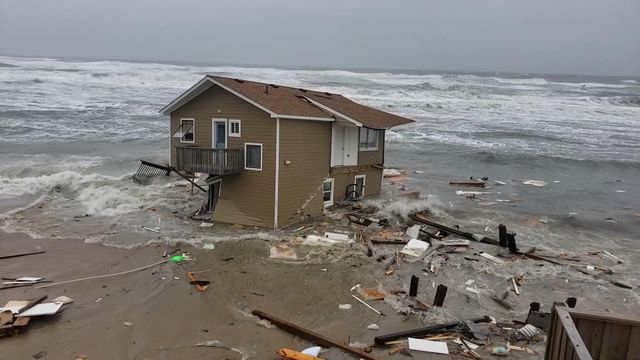Another Outer Banks house collapses; sea level rise due to climate change likely to make problems worse
As the Outer Banks experiences beach erosion, rip currents and overwash, which closed a segment of N.C. Highway 12 on Tuesday, another seaside house has collapsed.
Posted — UpdatedThe Cape Hatteras National Seashore said an unoccupied house collapsed at 24235 Ocean Drive in Rodanthe, prompting officials to close that segment of the beach to protect people from the large debris.
The Cape Hatteras National Seashore warned more homes could collapse this week as a coastal low impacts N.C. beaches.
"It's a combination of climate change (rising seas) and the strong coastal low," said WRAL meteorologist Aimee Wilmoth. "The coastal low is bringing in onshore winds and causing the high tides to be even higher."
The dangerous conditions in the Outer Banks and along N.C. beaches are connected to a low pressure system off the coast.
Coastal erosion and wave heights up to 15 feet are possible and a rip current risk is in place through mid-week at least. By Thursday, the system will bring rain to central and eastern N.C. as it moves onshore.
"With the low pressure staying off the coast through the middle of the week, strong winds will continue for the coast," WRAL meteorologist Peta Sheerwood said. "This will prompt northeast swells at some beaches. Beach erosion is likely for parts of the Outer Banks during periods of high tide, and strong rip currents are possible as well."
The National Weather Service has a coastal flood advisory in effect until 4 p.m. Wednesday, when 1 to 3 feet of flooding above ground level is expected in low-lying areas near shorelines and tidal waterways.
Climate change is contributing to more tropical storms and hurricanes, and experts say the N.C. coastline could start to shrink. A new report projects the U.S. sea level will rise as much in the next 30 years as it did in the past 100 years.
"Sea level rise is likely to continue to make these problems worse and make it even more challenging to manage these coastal areas," said David Hallac, superintendent of the eastern North Carolina branch of the National Parks Service.
Related Topics
• Credits
Copyright 2024 by Capitol Broadcasting Company. All rights reserved. This material may not be published, broadcast, rewritten or redistributed.






